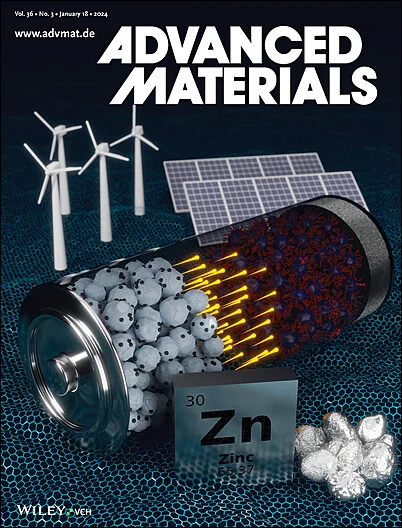Coupling Tensile Strain and Electronic Modulation in Mesoporous PdMo Metallene Nanoveins for Improved Oxygen Reduction
IF 26.8
1区 材料科学
Q1 CHEMISTRY, MULTIDISCIPLINARY
引用次数: 0
Abstract
Unraveling the fundamental determinants of the intrinsic activity of practical catalysts has long been challenging, mainly due to the complexity of the structures and surfaces of such catalysts. Current understandings of intrinsic activity mostly come from model catalysts. Here, a pH‐induced ligand adsorption strategy is developed to achieve controllable synthesis of self‐assembled low‐dimensional PdMo nanostructures, including 1D nanowires, 2D metallenes, and 2D metallene nanoveins. A strong correlation is established between the intrinsic oxygen reduction reaction (ORR) activity and the density of grain boundaries. Increased grain boundary density induces more extensive tensile strain, which, in synergy with electronic interactions within PdMo alloys, effectively lowers the energy barrier of the rate‐determining step (介孔PdMo金属烯纳米脉的耦合拉伸应变和电子调制提高氧还原性能
长期以来,揭示实际催化剂的内在活性的基本决定因素一直具有挑战性,主要是由于这些催化剂的结构和表面的复杂性。目前对本征活性的理解主要来自模型催化剂。本文提出了一种pH诱导的配体吸附策略,以实现自组装低维PdMo纳米结构的可控合成,包括1D纳米线、2D金属烯和2D金属烯纳米脉。本征氧还原反应(ORR)活性与晶界密度之间存在很强的相关性。晶界密度的增加引起更广泛的拉伸应变,这与PdMo合金内部的电子相互作用协同作用,有效地降低了速率决定步骤(*O到*OH)的能垒。二维PdMo金属烯纳米脉具有最高的晶界密度和独特的介孔结构,具有优越的ORR活性和质量输运能力。计算流体动力学模拟和原位光谱学被用来阐明结构-活性关系。这项工作为晶界工程在Pd基纳米结构中增强ORR电催化的关键作用提供了基本的见解。
本文章由计算机程序翻译,如有差异,请以英文原文为准。
求助全文
约1分钟内获得全文
求助全文
来源期刊

Advanced Materials
工程技术-材料科学:综合
CiteScore
43.00
自引率
4.10%
发文量
2182
审稿时长
2 months
期刊介绍:
Advanced Materials, one of the world's most prestigious journals and the foundation of the Advanced portfolio, is the home of choice for best-in-class materials science for more than 30 years. Following this fast-growing and interdisciplinary field, we are considering and publishing the most important discoveries on any and all materials from materials scientists, chemists, physicists, engineers as well as health and life scientists and bringing you the latest results and trends in modern materials-related research every week.
 求助内容:
求助内容: 应助结果提醒方式:
应助结果提醒方式:


